Built in 1967, the Garner Building is located at 125 East Laurel Street. It is a one-story brick building with elevated glass display windows. An open arcade through to rear with two decorative iron gates on the left and a decorative facade on the right. It was the home in the 1960s and 1970s of Lorchs Jewelry Store. After sitting idle for several years, this building became home to Berry and Dunn Office Supplies.
Current view: Berry and Dunn
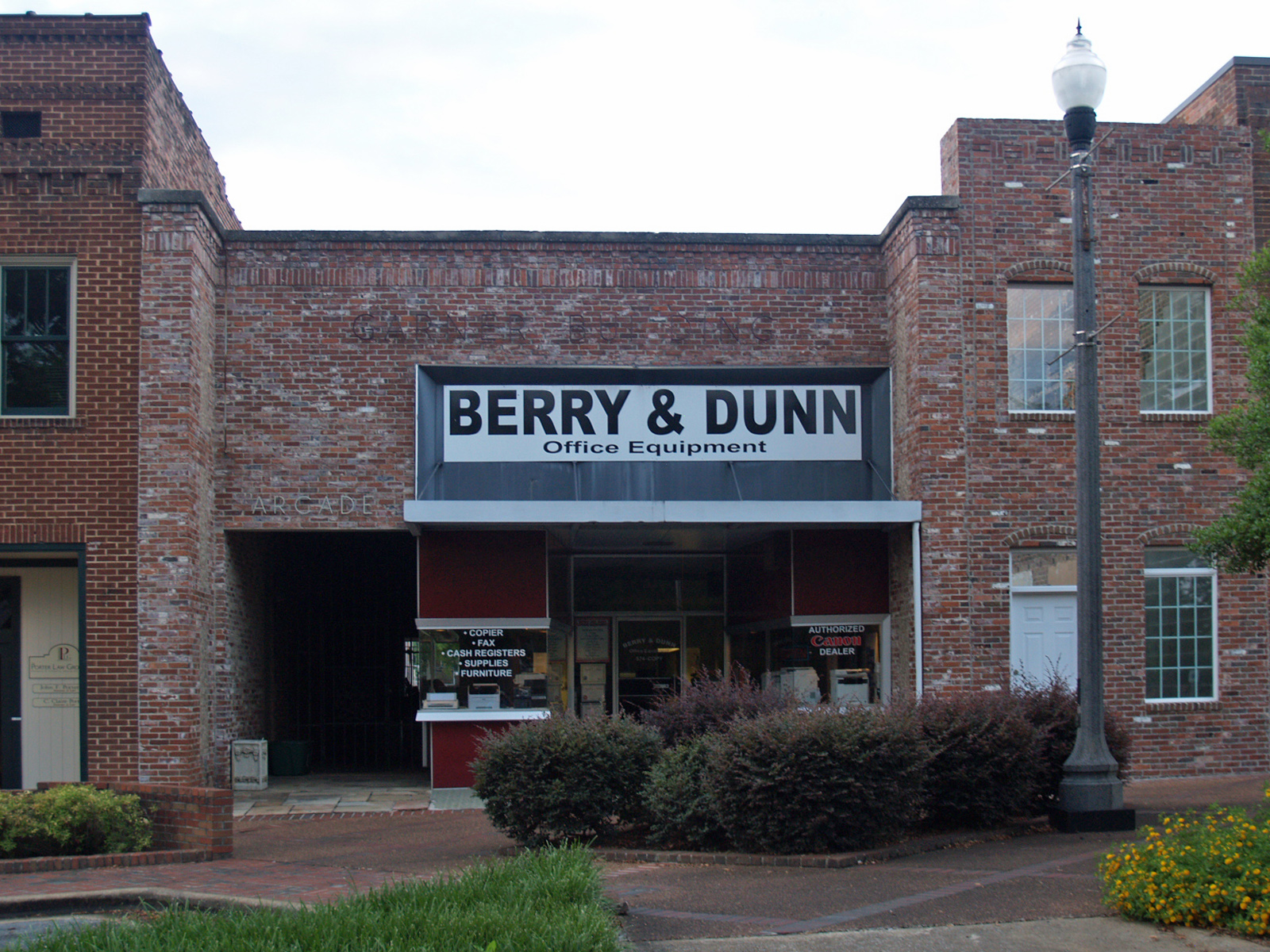
The mosaic created by the first tenant of this rebuilt space is still found in front of Berry and Dunn:

Deeds, tenants, and early occupants
It is not currently know what business occupied this space before the Bocanita was built in the late 1920s. This building on this site in 1918 was a large, two-story frame structure shown below, taken from a photo of the entire side of the square from 1917-1918. The house in the background belonged to the John B. Tally family.
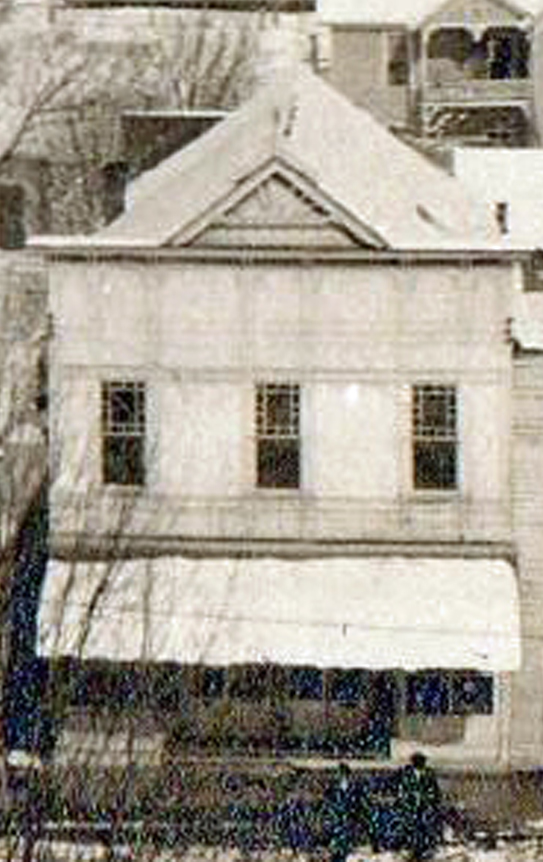
1930: Bocanita Theater
In 1956 and 1961 phone books, indeed from the late 1920s through the 1960s, this site was home to Bocanita Theater.
The Bocanita is the large, arched art deco building in the middle of the block. Notice the height of the back of the building to accommodate the balconies and projection booth.
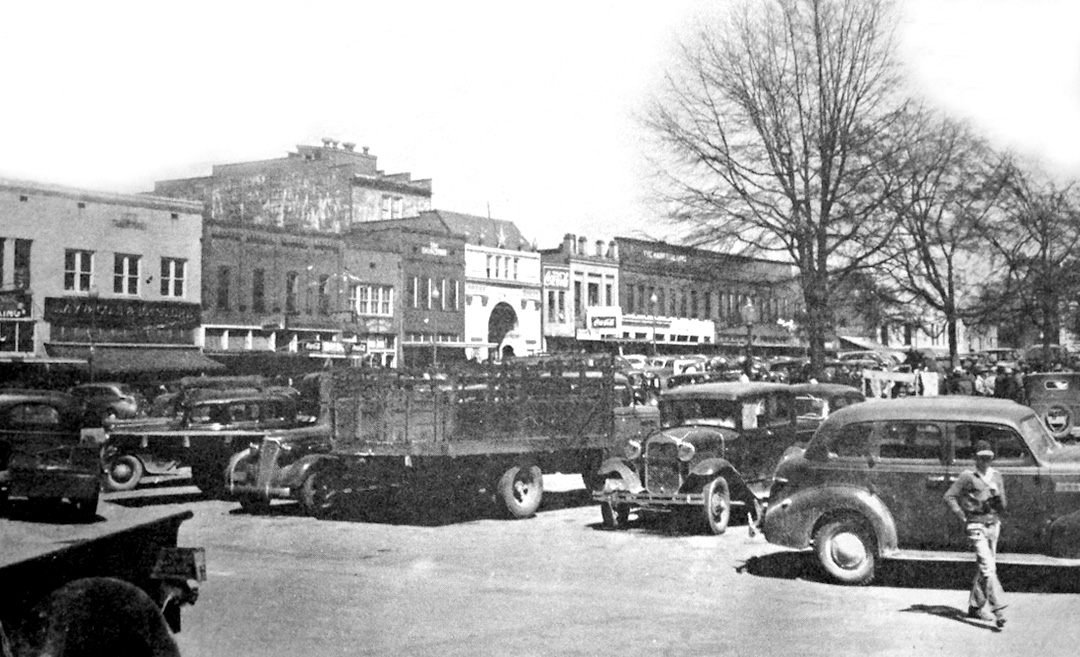
A typical newspaper ad from 1932
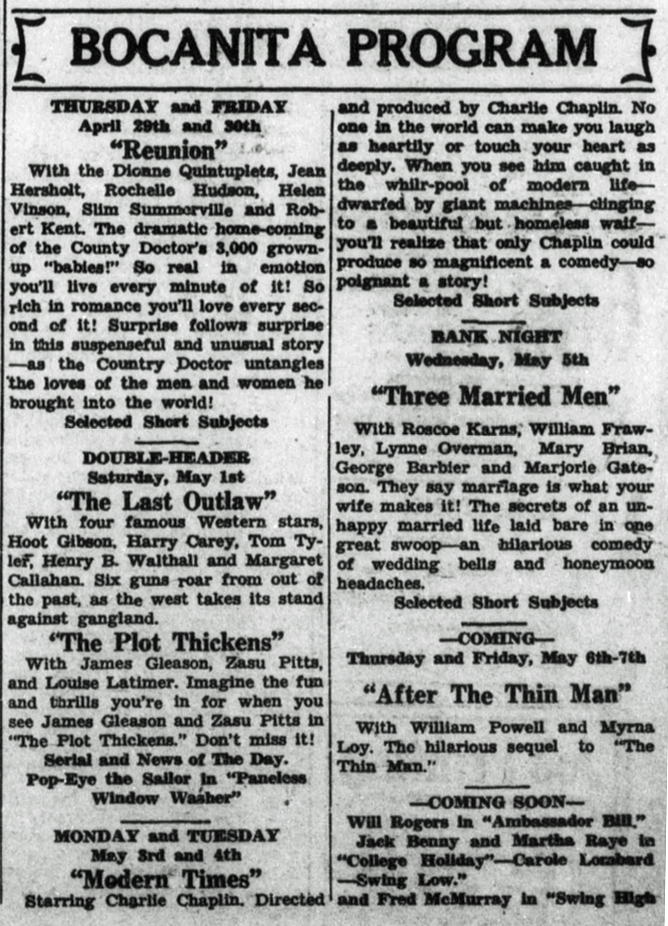
An ad for a live stage performance at the Bocanita
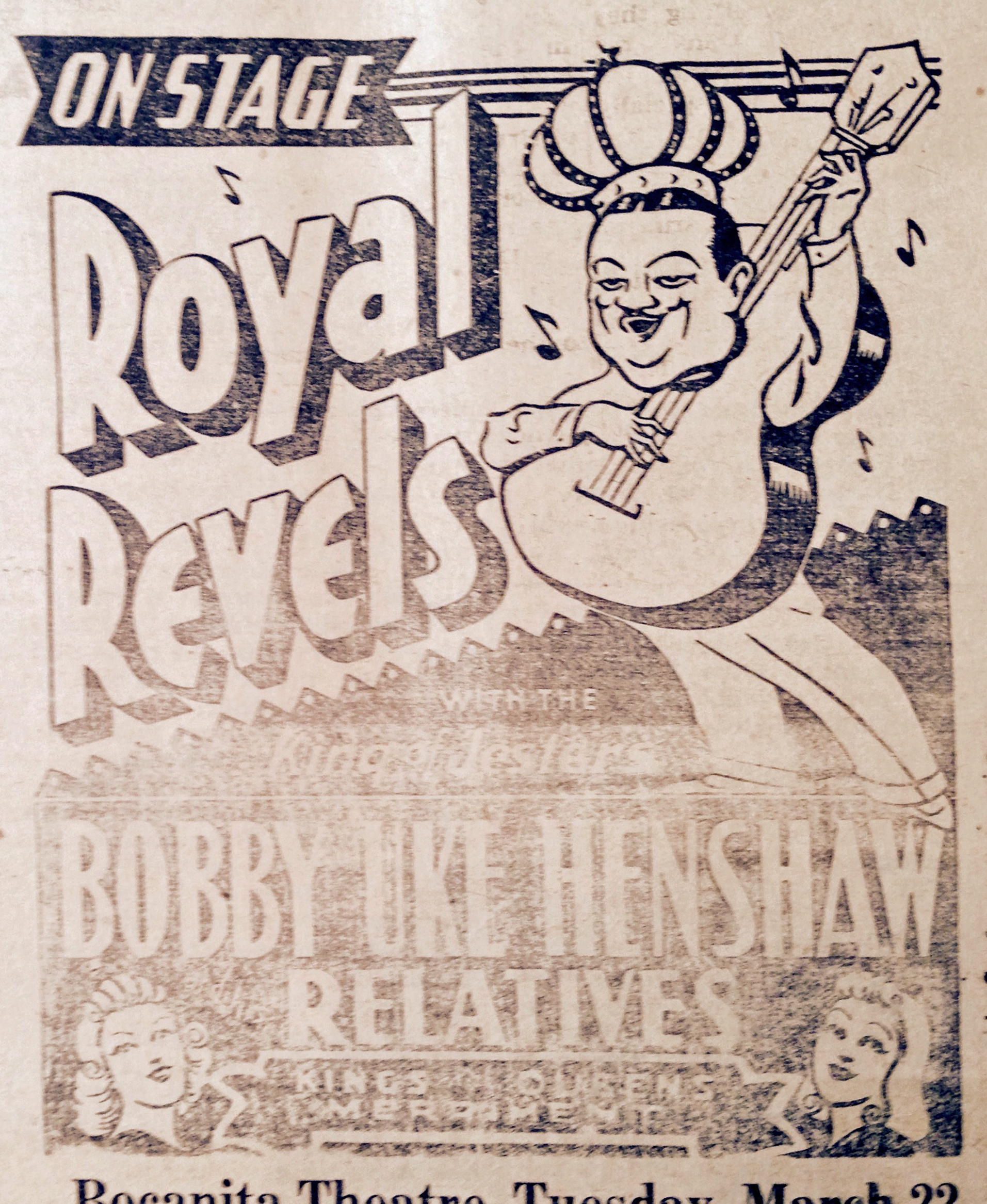
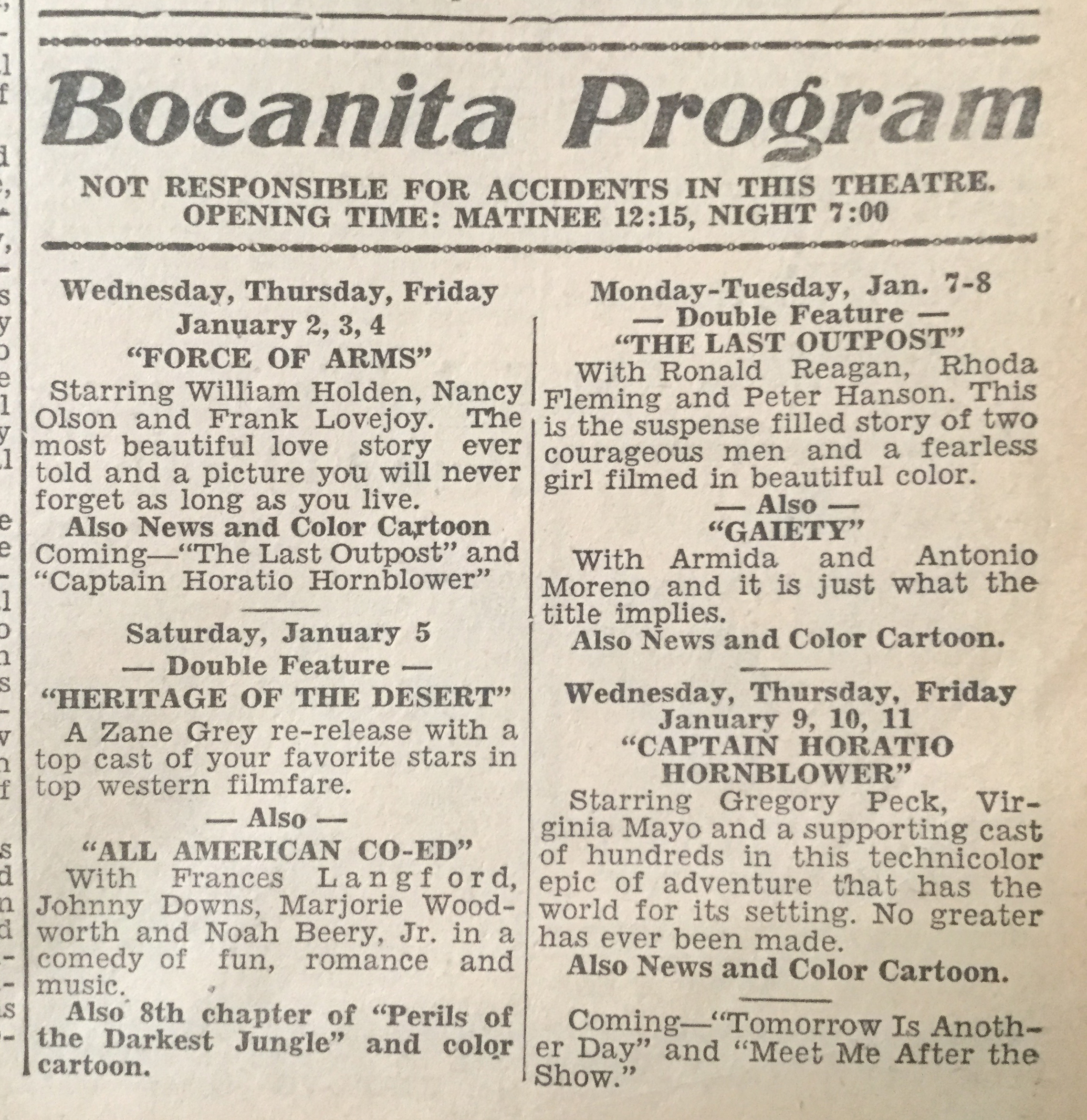
In April 2002, Reuben T. Miller, a former projectionist at the theater, wrote this description of the Bocanita in the Jackson County Chronicles.
In the late 1920s, Claude Bobo had a dream of an elaborate movie palace like those he saw in the business trade magazines he read. He was the “showing” in an old frame building located on the north side of the Scottsboro public square. He visualized a five-story movie house on that same location.So - the old building was pulled out into the street,leaving room for traffic and creating space for building the theater of his dreams. Meanwhile back at the movie,“showing”continued and income was generated, insuring the project’s funding. Financing for the movie “palace”came from a grand old lady all the town knew as “AuntTex.” Texas (Hess) Snodgrass was known as a firm business lady, but she also had a very big heart. That was actually her true nature. Continuing to ask for more and more money, Claude Bobo reached the 1932-astronomical sum of $35,000. Aunt Tex simply said, “No.” She foreclosed but kept Bobo as manager. Together they temporarily finished the building. A dirt floor was its fashion for several years. The projectors, standing almost “on their heads,” looked down from the projection booth. The booth itself was the penthouse on the fifth story atop two balconies, some living quarters, and the main (dirt) floor. An electronic vacuum tube, the 205D, was one of the final output pair which delivered the sound to a large Amplion horn speaker mounted directly behind the show-white screen. Then new to the movie business, this screen was perforated with tiny “sound holes,” allowing the sound to pass through to the audience who (before the new theater) had already heard the first synchronized sound-on-disc movies ever shown in Scottsboro, Alabama. Yes, the projectionist played a phonograph record which provided the complete sounds and dialogue while playing the movie on the projector.
Both phonograph and movie projector were mechanically coupled to keep sound and picture together. This worked well if the starting places were both properly observed. That is, unless the film had to be patched or repaired. In this case an exact amount of blank black film had to be spliced in to retain “synch,” to assure lips and words, sound, and action all occurred at the same time. All projection booths did not always have blank film at hand. Yes, it happened too often. When it did, a serious moment could become hilarious. The theater’s first projectionist experienced this problem. He said that without stopping he simply jumped the phonograph needle over one groove. It was in the right direction and the right amount.
The movie went on to conclusion without further incident. In the new building, sound-on-film had already arrived, and the sound-on-disc had already been discarded.Remember those projectors, “standing on their heads,” looking down from the fifth floor penthouse? The screen had to be tilted back a little at the top to have the image-carrying light beam perpendicular to the screen surface. This kept the picture from being trapezoidal, or wider at the bottom than at the top. It also made for good viewing in balconies and the ground floor, as well as the projection booth.
In 1933, a boy of seven, who had had polio (left leg) but had not yet had to go on crutches, begged a dime from his Mom to go see “Tarzan the Fearless” (serial) and Buck Jones - The Saturday Matinee. It was wonderful!
The next time the author went to the movies, Aunt Tex was “catching tickets.” As I handed her my ticket,she rose to her feet,quite put out over the situation and said: “Honey, you don’t have to pay to see ole Aunt Tex’s show.” She led me by the hand back to the box office, got my dime, and returned it to me.‘ Returning home, I told my Mom who said, “No, you must always offer to pay.” Well I did this the next time and got a genuine scolding from Aunt Tex. She said, “Honey, I told you that you get in free, and no matter who is on the door, you just tell ‘em Old Aunt Tex said you get in free.” When I told my Mom this, she agreed, and I had a pass to the movies until I became sixteen.
By that time I was working part-time as projectionist at the Bocanita Theater. The theater’s name is a story in itself. Remember Mr. Bobo? He had a close friend and relative named Charles Ambrester. Mr. Bobo’s wife’s name was Nita.
Bo for Bobo
Ca for Charles Ambrester
Nita for Bobo’s wife
BOCANITA
As for the rest of the story…..
Mr. Albert Petty was the projectionist throughout most of the theater’s life. He lived across the street from Cedar Hill Drive from 1933 to 1935. We were neighbors, and his son, A. W., and daughter, Una, were my playmates. His wife, Ova, saw some movies twice in order for each of my two sisters to accompany her as a babysitter. This enabled each of my sisters to see the movie for carrying home, on foot, a sleepy child.
We kept in close touch, and he knew of my interest and experimentation with “wildcat” radio stations and electronics in my early teens. When I was about sixteen, he sent for me to come learn his equipment and relieve him for lunch and supper.I was about eighteen when he gave me the 2050 for a keepsake. It had been taken out of service in 1932. Petty, as he was called by all of Scottsboro, died some forty year sago. His widow still lives here, now in her nineties.
And the Bocanita? It was torn down some time in the 1960s and replaced by a strip mall running from the public square to the back of the block. I was away in Huntsville, Alabama, “shooting” at the moon, following a ten-year stretch in radio during which I wore the hats of engineer-announcer, salesman, copywriter, and program director.
All I had left of the old Bocanita was the 205D. Being halfway through my eightieth decade, I decided time had arrived to arrange for the disposition of the hodgepodge collected during my lifetime. Fortunately, I came in contact with a collector of early electronic audio equipment who was overjoyed to acquire such a treasure as an intact 2050. l was pleased to pass this piece of personal history to someone whose appreciation of it matched my own. The new owner already possessed many similar components, including a theater amplifier. Now two elderly relatives have been reunited far away, the 205D and another Western Electric Movie Theater Amplifier, model 463, like the one in the old Bocanita.
I am grateful and proud for the small part I played in the lore and history of one our town’s best collective memories - the old Bocanita Theater with the beautiful art deco facade.
1940s: Unknown woman, City Cafe, and the Bocanita
Bill Parks tells me that the structure to this woman’s right is the ticket booth.

Aunt Tex Snodgrass’ Obituary, December 21, 1945

1975: Lorchs Jewelry
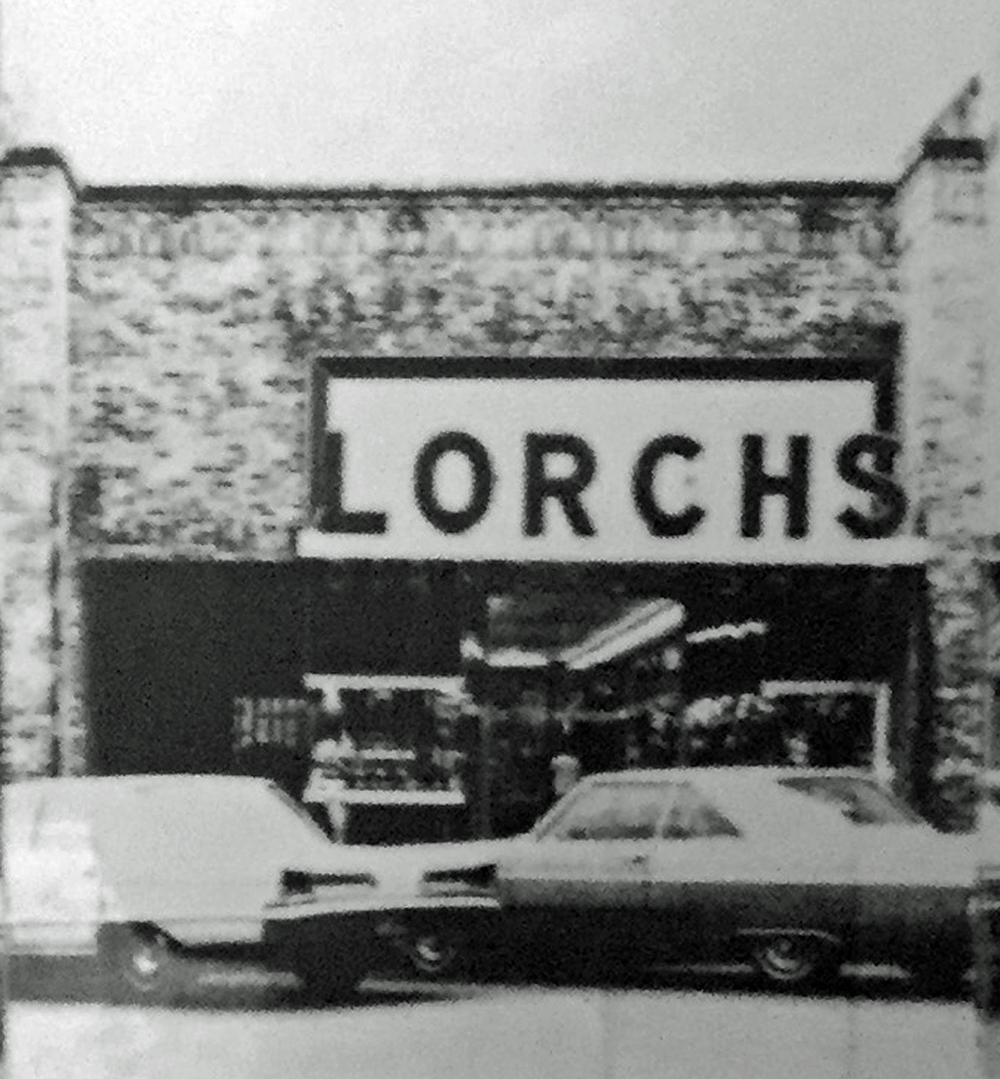
1980 Garner Building in a First Monday photo
Tales of the Boccanita
Bob Hodges wrote in his “Going Home Again”: “The other long line was at The Bocanita. The Bocanita never surprised you: there were things which you could plan on to be constant. You could plan on Mrs. Allie Mae Hurt being in the lobby, selling popcorn for a dime at one machine and hard tack at the other for a nickel. Also, you could count on one song before the movie started, the same one every time, played while the lights were still on: Bob Wills and the Texas Playboys singing “My San Antonio Rose.” Charlie Webb was the enforcer at the Bocanita, but for some reason, he did not strike fear in us as did Philco. Charlie always struck me as a very nice and compassionate man who should have been in another line of work.”
Bill Parks remembers the exotic urns at the top of the Bocanita and remembers that when he was a boy, you could get into the movie with five arrowheads. He remembers going across the street from his house on Byron Road and looking for arrowheads so he could go to the movie. David Bradford recalls that Mr. Claude Bobo wanted the arrowheads because he had planned to do a mosaic with arrowheads in the lobby of the Bocanita, and he collected them for that reason, though the mosaic was never created. It is not known what became of his collection.
Was the Bocanita the first Scottsboro theater to show “talkies”?
In an interview in the April 17, 1930 newspaper, The Progressive Age, Claude Bobo, who would manage the Bocanita, was quoted as saying:
“Due to the bad slump in our attendance now and desiring to get our patrons accustomed to the talkies before getting into the new theater, we have decided to install [a] sound system temporarily in the Dreamland Theater” [located in the Claybrook Building].
However, it is likely that the Bocanita opened before the Dreamland’s conversion because less than a month after Bobo announced his plans for the Dreamland, an advertisement for The City Cafe in the “Progressive Age” announced its location as “next door to the new Bocanita Theater.” (May 8, 1930)
It is possible that the City Cafe ad referred only the intended site of the new Bocanita rather than the completed building, since work on the theater was prolonged by Claude Bobo’s mounting ambitions for the place (The Fox Theater in Atlanta was said to be his model). When Bobo’s expenditures reached $35,000, his financier, Aunt Tex Snodgrass, reined the project in, leaving the Bocanita with a dirt floor for the first few years of its existence.
Is it possible that Miss Sid Telford played the organ for silent movies in Scottsboro, either at the Dreamland or the Bocanita? If you know the answer to this, please write us. This question drew this response from Bill Tally: I think she did. I do know that there was entertainment in addition to the movies. As an older child, my mother tap danced at the Bocanita before the movies, most likely to the accompaniment of her piano teacher, Miss Sid. She was known as a marvelous piano teacher.”